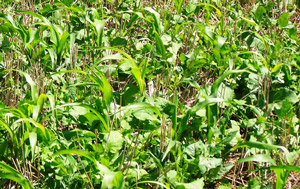What Can We Expect from Forage Cover Crops?
January 2016

Variable production
There are (and should be) variable growth and production patterns for forage cover crops. Since forage cover crops are planted following grain crop production, their growth is influenced by
- the amount of light penetration (affected by residue amount),
- water availability (including soil moisture plus precipitation),
- appropriate growth temperature (planting date and accumulated growing degree days), and
- soil fertility (residual N and availability of nutrients).
Based on the grain crop they follow, any combination of these conditions can limit forage cover crop growth.
Ease of forage cover crop establishment ranges from very easy, following wheat, hybrid seed corn, and corn silage production, to challenging following corn grain production. The probability of success is very high following wheat, hybrid seed corn, and corn silage production, but only moderately successful following soybean production. The relative ease and success rate is clearly related to planting date of the forage cover crop.
Variable nutritional value
There are (and should be) differences in forage quality for forage cover crops. This is because many different warm-season and cool-season grasses, legumes, and forbs are used as monoculture or mixed forage cover crops. As a general rule, warm-season grasses have lower nutritional value than cool-season grasses and grasses have lower nutritional value than legumes. Brassicas and other broadleaf species and forbs often have quite high nutritional value. The nutritional value for mixed forage cover crops depends greatly on what plant species are included, how much is produced by each species, and what the animals select to eat.
Season of growth and plant maturity are important factors for determining nutritional value. For example, most forage cover crops have outstanding nutritional value during the fall. The exceptions are warm-season species, such as the early-planted sorghums or millets and some of the early-planted spring species such as oats or spring barley. All of these species will likely reach a reproductive stage of growth when planted in July immediately following wheat, so the nutritional quality is usually lower. The nutritional value of forage cover crops planted from mid-August through early September is high with total digestible nutrients (TDN) ranging from 70 to 80%. Crude protein (CP) will vary from 10 to 20% depending on the amount of N available for plant uptake.
Variable animal gain
There are (and maybe should be) differences in animal gain when grazing forage cover crops. There is minimal data available on beef gains from grazing forage cover crops. Most of the reported animal gains are observational or testimonial based, rather than from sound research. Therefore, they may be reliable only for unique conditions.
Animals grazing forage cover crop mixtures, that are mostly brassica, are reported to have lower gains than animals grazing forage cover crop mixtures. Most of the differences in animal gain from grazing forage cover crops are caused by the differences in forage production and nutritional value. However, there are other factors besides yield and quality that influence gain, such as rate of passage.
For example, many brassicas have low dry matter, low fiber, and high soluble carbohydrates, which results in extremely high digestibility and nutritional value. Even though these characteristics are used to define high quality forage, the quality may be too high for ruminant animals. Producers who provide a dry forage like straw or hay free choice while grazing brassicas often report 0.5+ lb/day improvement over no additional forage.
Forage cover crops grazed during the spring can still have variable animal gains. However, these differences are more easily attributed to the maturity differences of the forage cover crops. As plants mature in the spring, the nutritional value of small grain forages declines as forage yield increases. When small grain forages are in the boot stage, TDN will have decreased to 50 to 60% with CP around 8 to 12%.
Summary
There is limited information on seasonal forage cover crop production potential or animal gain for many forage cover crops. The available grazing performance data suggests that opportunities exist for improving the management of forage cover crops in many cropping systems. While there are many positives to incorporating forage cover crops into existing forage systems, differences in production, nutritional value, and animal gain exist.
Daren Redfearn
Nebraska Extension Forage and Crop Residue Specialist
Jerry Volesky
Nebraska Extension Range and Forage Specialist
Bruce Anderson
Nebraska Extension Forage Specialist